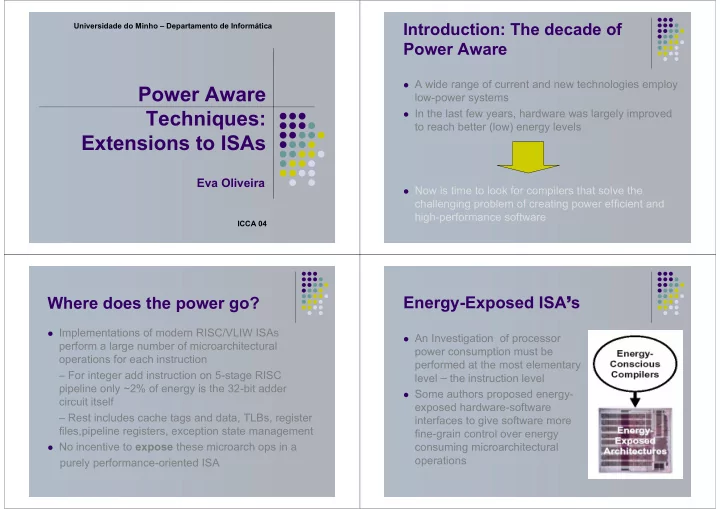

Introduction: The decade of Universidade do Minho – Departamento de Informática Power Aware � A wide range of current and new technologies employ Power Aware low-power systems Techniques: � In the last few years, hardware was largely improved to reach better (low) energy levels Extensions to ISAs Eva Oliveira � Now is time to look for compilers that solve the challenging problem of creating power efficient and high-performance software ICCA 04 Energy-Exposed ISA ’ s Where does the power go? � Implementations of modern RISC/VLIW ISAs � An Investigation of processor perform a large number of microarchitectural power consumption must be operations for each instruction performed at the most elementary – For integer add instruction on 5-stage RISC level – the instruction level pipeline only ~2% of energy is the 32-bit adder � Some authors proposed energy- circuit itself exposed hardware-software – Rest includes cache tags and data, TLBs, register interfaces to give software more files,pipeline registers, exception state management fine-grain control over energy � No incentive to expose these microarch ops in a consuming microarchitectural operations purely performance-oriented ISA
Energy-Exposed ISA ’ s Energy-Exposed techniques � A RISC microprocessor was � Software restart markers: improves modified to support the three exception state managment, dividing techniques proposed the instruction stream into restartable � Compiler algorithms were regions developed to target the enhanced � Bypass latches: eliminate register files instruction set traffic � Tag unchecked loads and stores : optimize the hardware tag check time by eliminating it Software Restart Markers Software Restart Markers � Current pipelined machines invest significant � Actual machines provide some mechanisms energy in preserving precise exception to manage exceptions semantics � Precise exceptions are supported in a � Instructions results are buffered before pipelined machine committed in order, requiring register � hardware must either buffer updates in form of renaming logic to find the correct value for future files until all possible exceptions have cleared, or … new instructions � save old machine state in history buffers, so that it � Even a simple five-stage RISC pipelined has can be recalled when exceptions are detected a bypass network
Software Restart Markers: Software Restart Markers Compiler Analysis � SRM reduce energy cost of exceptions managment by requiring software to explicity divide the instruction stream into restartable regions � These schemes add additional exceptions state managment energy overhead to the executions of all instructions Bypass Latches Bypass Latches � Giving software explicity control of the � Half of the values written to the register file bypass latches, it is possible to reduce the are used exactly once, usually by the register file traffic considerably instruction executed immediatly after the one producing the value. lw, RS, (r3) add SD, RS, 1 lw r1, (r3) load value Same performance, but writes and reads add r1, r1 , 1 increment have been avoided and replaced with accesses to the bypass latches
Tag-Unchecked Loads Bypass Latches and Stores � Reduced register file activity � Memory system, including caches, consumes a significant fraction of system power � only write to bypass latches, not regfile � reduce reads from reg file on avergae 28% � Tag check in the primary data cache is one significat source of energy consumption � On average, 34% of all writes are eliminated Direct addressing allows software to cache data without the hardware performing a cache tag check Compiler Algorithm (C) Tag-Unchecked Loads and Stores � Loop unrolling to increase aligned references � The compiler often knows when the program is � An array of 64 bits-data and the cache line size accessing the same piece of memory. Don’t check the cache tags for the second access of 32 bytes � HW challenge — make this path low power � SW challenge — find the opportunities for use. � Compiler algorithms for C languages � Interface challenge — minimize ISA changes, don’t disrupt HW, don’t expose too much HW detail. � Data cache energy reduction 8.7 - 40%
Conclusions Conclusions � Instructions perform many hidden � Software restart markers reduce this microarchitectural operations as they execute overhead by enabling the introduction of temporary state that does not have to be � Compile-time analysis can statically saved and restored across exceptions. determine that much of the work is unnecessary � Exposed bypass latches are an example of allowing software to make use of temporary � By providing an energy-exposed instruction state to avoid microarchitectural operations at set, this analysis information can be run time; in this case register file reads and transmitted to the hardware to save energy write are statically eliminated. without impacting performance Conclusions � Tag-unchecked loads and stores are an example which use compile time analysis to access the cache with direct address registers instead of costly tag checks.
Recommend
More recommend